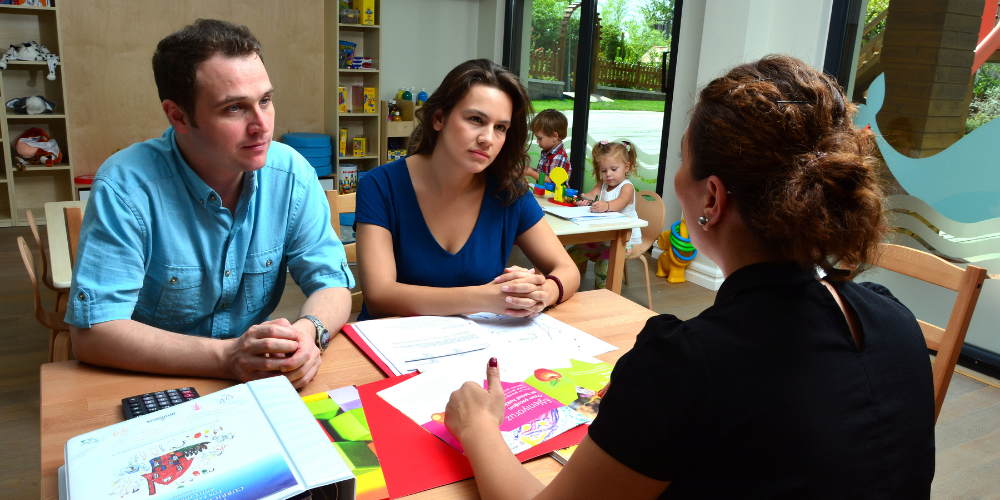Sometimes, the most difficult part of being a teacher isn’t about the kids, it’s about the parents. Communicating with parents can be a challenge for even the most experienced teacher, especially when you’re faced with difficult parents whom you may not see eye-to-eye with.
Parent-Teacher Communication does not need to be the most stressful part of teaching. With preparation and perspective, you’ll hardly break a sweat!
1.) Keep Your Cool
When dealing with a parent that challenges you, maintain your composure. Use the common interest of both parties (keeping the student at the center) to reach the parent who may be difficult. Often, a parent is frustrated and is lashing out at the nearest person, you. Don’t take their yelling personally, and certainly do not raise your voice in return. Yelling at each other will accomplish nothing. Advancements can only be made when there is dialogue and understanding.
2.) Build the Parents/Guardians’ Trust
One technique to build trust is to touch base on a regular basis. Parents want to hear the good things that are going on in a classroom vs. only hearing from you when something goes wrong or when the student is in trouble. Sending a quick note or making a call shows the parent your interest in the child. A quick email or call to the parent saying that their child did a great job on something or performed a random act of kindness can go a long way in building rapport with the parent. It shows that the teacher is looking at all the good things a child does and is not strictly focused on the bad. These quick little notes lead to positive perception and parents will recognize the good intentions you have for their child.
3.) Reach out to the Community
Reaching out to the community can build support for teachers. This is a win-win-win situation. Students win as they showcase their skills and gain the euphoria of helping another. The community wins as they see their young citizens showing concern for the community. The school wins as it can get great press and the community may look more favorably on the school’s needs. This positive community engagement can show challenging parents that you have taken concrete steps to put the best interest of the student first. After all, it takes a village.
4.) Show You Care
Parents want to see a teacher who truly cares about their children. On Back to School Night, greet families at the door and provide light refreshments. While reviewing important information, try to include some of the positive things the students are doing. Stress a caring environment that will allow students to learn in a safe zone. Encourage parents to contact you regarding their concerns – no matter how trivial.
5.) Establish Your Authority
Another measure to present confidence and authority in a difficult situation is to look the person directly in the eye. It shows that you are interested in what is being said. You are concerned about the situation and are actively listening to acquire all the information. Second, you are showing respect to the other person by giving them your undivided attention. What they say means a great deal to you. Third, “looking a person directly in the eye gives you an air of self-confidence and self-assurance.” (80) This perception can help diffuse a difficult situation. By displaying self-confidence, you can turn a lopsided conversation into one of equal cohorts who have a mutual objective, the best interests of the student.
6.) Speak with a Low Voice
One technique that is helpful is to lower your voice. Parents who are upset often use a higher than normal volume due to emotion. It is quite common for the person on the receiving end of this conversation to become nervous. When one becomes nervous, coherent sentences are often lost. A person’s voice can become shaky and lack confidence. With the lowered volume, the shakiness in the voice will become less obvious. In addition, the decreased volume forces the other party to focus more closely on what is being said. Instead of focusing on their needs or concerns, the upset parent must channel additional energy to listen to what the other person is saying. Furthermore, the upset parent will start noticing how loud they are speaking and how this will not benefit the conversation.
7.) Realize Everyone Makes Mistakes
Everyone makes mistakes. You have many responsibilities and because of that, you may make mistakes. It happens, you’re human! When a parent brings an error to light, the proper procedure for the school (teacher or administrator) is to be gracious and accepting of the information. If the parent is taking the time to bring attention to the matter, the school must be willing to put in the time to investigate. By acknowledging the possibility of an error and looking into it, the parent feels that the school cares enough to do the right thing. An investigation must be done in a timely manner and the results shared with the parent. If youhave made an error, it should be quickly rectified and an apology extended.
8.) Show Empathy
The words, “I am so sorry that happened” are highly effective. These six little words convey a great deal. First, it shows that you listened to what was said and are concerned about everyone’s well-being. In addition to acknowledging what happened, you are providing an opportunity to establish rapport with the other party. Acknowledgment shows concern and a willingness to address the matter. Sometimes, the person just wants a shoulder to cry on. Other times, a wrong may have occurred and this person would like a remedy. Either way, you have put a priority on the person’s situation. By stating that you are sorry the situation occurred, you can calm an irate parent down and provide an opportunity to have a calm conversation to obtain the details and problem-solve with the child at the center. This is a highly effective way to have a discussion and increase relations.
9.) Use and Show Concrete Examples
Documentation of observations, data, and other qualitative and quantitative information provides a different focus for both you and the parent. When presented with “the facts”, parents must focus on the issue at hand instead of their emotions. Just be sure you are sharing positive concrete examples and improvements as often (if not more often) than data showing challenges. Use your information to push toward problem-solving vs. problem identification, and always keep the needs of the child at the center of the conversation.
10.) Set up a Parent Resources Area
When parents are difficult, it is often because they are at a loss. They may lack the skills, will, or knowledge to help their child. Consider a parent resource library filled with a multitude of resources. This space should be an inviting place. A soft color pallet on the walls, comfortable chairs, and computer access would be helpful. Resources for the parents should be grouped according to grade level and subject. Parents can see what the scope of the curriculum is. Past projects can be placed on display. Future projects can be listed with the hope of parental expertise can be shared. If there is something that a teacher would like parent assistance with, there can be a board to post the “position”. Parents must feel welcomed in the building. Due to our current environment, schools and teachers should consider an online parent resource center.
This blog was first published in 2016 by middle school math teacher, Kelly Ann Ydrovo after completing our continuing education course 859: Parent Trap: Achieving Success with Difficult Parents & Difficult Situations. It has been updated for accuracy and applicability in 2022.








